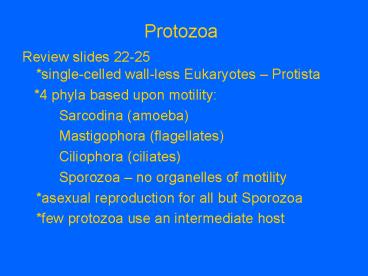Protozoa - PowerPoint PPT Presentation
1 / 12
Title:
Protozoa
Description:
anemia, weight loss & elevated alkaline phosphatase due to liver damage, ... b) crater-shaped liver abcess. c) liver abcess damage tube of 'chocolate puss' ... – PowerPoint PPT presentation
Number of Views:332
Avg rating:3.0/5.0
Title: Protozoa
1
Protozoa
- Review slides 22-25
single-celled wall-less Eukaryotes Protista - 4 phyla based upon motility
- Sarcodina (amoeba)
- Mastigophora (flagellates)
- Ciliophora (ciliates)
- Sporozoa no organelles of motility
- asexual reproduction for all but Sporozoa
- few protozoa use an intermediate host
2
Protozoa
- Intestinal and urogenital protozoa
- pathogens
- commensals / non-pathogens
- Blood and tissue parasites
3
Intestinal ameba
- Pathogens Tom vs text Entamoeba
histolytica Dientamoeba fragilis
(flagellate without flagella - Tom) Blastocystis
hominis - Commensals significant as look-alikes, esp. E.
histolytica Entamoeba dispar Entamoeba
coli Entamoeba hartmanii
Endolimax nana Iodamoeba butschlii
4
Focus on pathogens Entamoeba histolytica
- Facts / life-cycle simplest possible life-cycle
direct fecal-oral transmission through fecal
contaminated food or water. Cysts ingested
release 4 trophs in intestine. Common in highly
populated under-developed areas. Poor hygiene,
poor infra-structure ingestion of raw or
undercooked contaminated food or water is the
problem (same old story). No need for IH or
environmental maturation. Only cysts can survive
outside of body. - Epidemiology 5x107 infections worldwide with
infection rates 50 in endemic areas such as C.
S. America, Africa, Asia. Accounts for
100,000 annual deaths. Hot spots include
Bangladesh, Brazil, Mexico City, Manilla.
Infection rates of the U.S. population in some
areas reach 3. Children are the primary hosts
of the organism. Why?
5
Focus on pathogens E. histolytica
pathology/clinical symptoms
- Note since diagnosis of protozoans strictly by
morphology is more difficult, symptoms are used
as more of a clinical tool in protozoan
infections than in helminth infections. - 90 of patients are asymptomatic contributing to
the spread of disease. Long term infection will
result in pathogenesis. Damage may go unnoticed
for some period of time. Trophs are responsible
for all pathology.
?
6
Focus on pathogens E. histolytica
pathology/clinical symptoms cont.
- Intestinal may be a single event or recurrent
- a)amoebic colitis cramps with alternation
between loose stool and constipation - b)dysentery seen in 0 of infected patients
- hydrolytic enzymes penetrate small hole or
ulcer in mucosa, reaches musculature spreads
laterally causing significant undercutting
severe pain, sloughing of mucosa ? blood mucus
in diarhea, tear drop or flask-like
intestinal lesions.
?
7
E. histolytica pathology continued
- extraintestinal involves a small fraction (0.5)
of infections. Trophs perforate bowel causing
peritonitis, and travel to other organs - liver crater-shaped abcesses on surface of
liver with chocolate colored exudat - anemia, weight loss elevated
alkaline phosphatase due to liver damage, - abcesses in brain, lung, kidney even more rare
8
Typical pathology of E. histolytica a)
flask-shaped abcess in mucosa b)
crater-shaped liver abcess c) liver abcess
damage tube of chocolate puss from abcess
9
(No Transcript)
10
Focus on pathogens E. histolytica diagnosis/ID
- Diagnosis can be difficult due to varied clinical
symptoms and presentations of the organism, as
well as similarities with the commensal Entamoeba
species. READ text on pg 1082. - Molecular methods recently indicated that 80 of
cases previously thought to be E. histolytica
were actually infections of commensal species
such as E. dispar. 500,000 ?100,000 - Cysts are present in formed stools cysts
trophs in semi-formed stool. Both trophs and
cysts can be diagnostic in both wet preps and
permanent stained smears. Demonstration of
characteristic cysts and trophs in permanently
stained smears is necessary for accurate
speciation. Debbie? Is this true? - Toms slides ?
11
Focus on pathogens E. histolytica diagnosis/ID
cont.
- Diagnostic features of trophs in wet preparations
- Directional motility by way of hyaline (glassy,
transparent) elongated or finger-like pseudopods - May contain RBCs ingested via phagocytosis
- Nuclear details not visible or definitive
(requires permanent staining)
12
(No Transcript)































